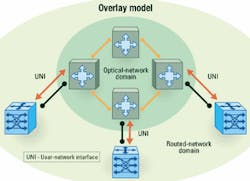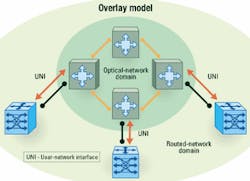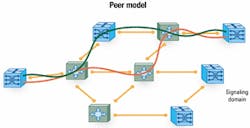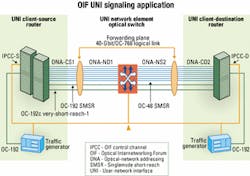The road to dynamic bandwidth provisioning: OIF UNI or IETF GMPLS?
Which of two technology choices for the integration of optical switching and IP/MPLS routing works best depends on application and deployment schedules.
ADAM DUNSTAN, Optical Internetworking Forum
Demand to deploy new, profitable services quicker is one of the drivers leading to deployment of custom high-capacity connections across the network. And using signaling implementations, network elements such as routers and optical switches can provide more dynamic provisioning of capacity based on need across an optical IP network. Circuits can then be subsequently modified to change the amount of bandwidth allocated, or the circuit can be deleted altogether.
In addition, composite trunking technology allows carriers to aggregate multiple physical links to form one logical higher capacity pipe with a single IP address. It complements optical signaling by supporting the creation of logical connections between the IP and optical layer. A composite trunk can consist of up to 64 physical SONET/SDH links to form a single logical connection. The benefit is efficient, more flexible use of optical facilities.
Dynamic provisioning reduces carriers' operational expenses and time-to-market by provisioning via a device's control plane interface rather than by manual, physical reconfiguration of ports and trunks. That gives carriers the ability to offer high velocity provisioning across the network from a central location with minimal cost and maximum speed.To address this need for more dynamic provisioning of bandwidth, carriers require solutions that support communication between the optical switches in the transport layer and the core routers in the IP service layer. This integration of optical-switching technology with IP/MPLS data networking is accomplished using one of two principal architectures: peer or overlay.
In the user-network interface (UNI) overlay model developed by the Optical Internetworking Forum (OIF), the data network and the optical network each maintain separate topologies (see Figure 1). That allows separate administrative domains for network operation. Data devices discover the services offered by the optical network through their connection to an optical switch. IP-based signaling protocols establish connections between the data devices through the optical-network domain. OIF UNI signaling validates the industry requirement for open platforms, which enable customers to select best-of-breed technology. The OIF brings together packet and optical-networking vendors to accelerate the deployment of interoperable, cost-effective, and robust optical internetworks and their associated technologies.
The peer model, as proposed by the Internet Engineering Task Force (IETF) under the name of Generalized MPLS (GMPLS), establishes optical switches and MPLS-based routers as peer devices with different interface attributes (see Figure 2). A single topology is maintained for all data and optical devices, which allows MPLS-based connections over hybrid data/optical switched paths. IP-based signaling protocols are used to establish these paths.
Both models use the basic signaling resource reservation protocol (RSVP) and the same signal attributes for link or path establishment. The choice of models largely depends on the applications or services that will be carried in the network and the proposed deployment timeline.
As carriers begin to converge IP and MPLS on their services network to support MPLS-based packet traffic, GMPLS offers an alternative. When the transmission network is used to deliver a wide array of wavelength and higher-level data services, OIF UNI provides greater service flexibility and allows the implementation of administrative control spans.If planned deployment is within the next 12 months, OIF UNI offers an advantage in terms of availability. The OIF announced in October of 2001 that its membership had approved a signaling specification for the OIF's User Network Interface (UNI) 1.0. The specification defines the signaling protocols implemented by client and transport network equipment from different vendors to invoke services, the mechanisms used to transport signaling messages and the auto-discovery procedures that aid signaling. Developed by the OIF's Technical Committee, the new specification is the result of work by the Forum's Architecture, Carrier, Operations Administration, Maintenance & Pro visioning (OAM&P), and Signaling Working Groups. OIF UNI is available to carriers earlier than GMPLS, because it had a head start in development and the interoperability arena.
The IETF is working on extending MPLS and IP routing protocols to include optical functionality. As a result, most router vendors that support MPLS will also support GMPLS. Most of the extensions in the base GMPLS documents involve providing information that is used to manage mixed electrical and optical switched paths. A key component of GMPLS is link-management protocol, which provides a means for switches to communicate the available network topology to routers, although it does not necessarily provide enough information to determine the feasibility of specific optical paths (for example, if an optical path from point A to point Z by way of B, C,...Y would really work). Other important functions include link bundling-efficiently advertising the availability of such things as bundles of lambdas between A and B-and unnumbered interfaces, which are conceptually simple but more difficult to implement due to the level of code assumptions. Any interface can be referenced by a globally unique IP address.
At the June SuperComm 2001 trade show, a number of demonstrations showed the capabilities of the newly completed OIF UNI specification, Optical UNI 1.0. The official OIF demo included 25 vendors demonstrating interoperability on user-initiated optical service provisioning. The vendors were divided into two groups. The UNI-N or network side of the connection included devices such as optical switches, and the UNI-C or client side of the connection included devices such as routers and multiplexers. There were 15 clients and 14 network devices (optical-network elements) involved. All of the participants had completed interoperability testing at the University of New Hampshire. The key components of the OIF demo were:
- Optical connection set-up and tear-down.
- Out-of-band RSVP traffic engineering-based signaling with UNI extensions.
- IPv4 optical-network addressing.
Separately, two vendors that participated in the OIF demo-an IP router maker and an optical-switch provider-performed an independent and more extensive display of OIF UNI 1.0 signaling for dynamic provisioning of bandwidth across the optical core.
OIF UNI de-couples the control plane signaling and routing from the user data plane. In both the OIF and the independent vendor demonstration, the OIF control channel (IPCC) signaling was specified out of band over a shared Ethernet network that was physically separate from the optical links.The IPCC allows a network element to request the addition or deletion of optical-layer capacity using connection establishment and teardown requests. In this demonstration shown in Figure 3, the IP core router used OIF signaling to identify the transport links in the composite trunk bundle to the optical switch. Once the interfaces were operational, data was transported across the links. When the optical switch received an RSVP path message from the router with the port ID of a specific physical fiber link, it cross-referenced this information in an internal neighbor discovery table to determine its corresponding port ID for this connection, as well as the trunk side port ID, to activate and signal in a path request message to the destination router. Finally, the destination router compared the information received in the incoming RSVP path message against its own neighbor discovery table to determine the specific physical port to activate.
For this demonstration, the data path between the core router and the optical-switch equipment consisted of five OC-48c composite member links presented as a single logical 12.5-Gbit/sec connection.
The benefits of the independent vendor SuperComm demonstration included:
- The OIF optical UNI signaling provided a standards-based interface to allow IP core routers to dynamically provision connections across an intelligent optical-core network.
- Dynamic provisioning of high-capacity links reduced operational complexity of service activation.
Composite trunking simplified the provisioning and management of routing tables by providing a single IP prefix or MPLS label to represent a logical "fatter" pipe composed of multiple physical connections. Composite member links can have a 4:1 speed differential (e.g., OC-12 with OC-48 or OC-48 with OC-192).
The SuperComm demonstrations provided a valuable proof point for the feasibility and practicality of using OIF UNI for dynamic bandwidth provisioning in the near future. Subsequent work after SuperComm among industry participants led to the completion of OIF UNI 1.0. More work lies ahead in collaborating with customers to leverage OIF UNI for dynamic provisioning of bandwidth in a carrier network environment. Forward-looking carriers are beginning to test OIF UNI for eventual use in their networks.
While the recent demonstrations focused on communications between the various vendors, the next steps for finalizing interoperability are "neighbor discovery" and "service discovery." The ability to set dynamic thresholds to add or delete light path links is a key component since it truly automates what previously has been a manual process.
At SuperComm, different combinations of optical-switch and -router vendors tested against one another and the results were added to the work being done on the specification. With completion of the UNI specification last October , the next steps will center on network-to-network interfaces for dynamic provisioning across the entire optical network.
Adam Dunstan is vice president of strategy and business development at Avici Systems Inc. (North Billerica, MA). He also served as president of the Optical Internetworking Forum.



